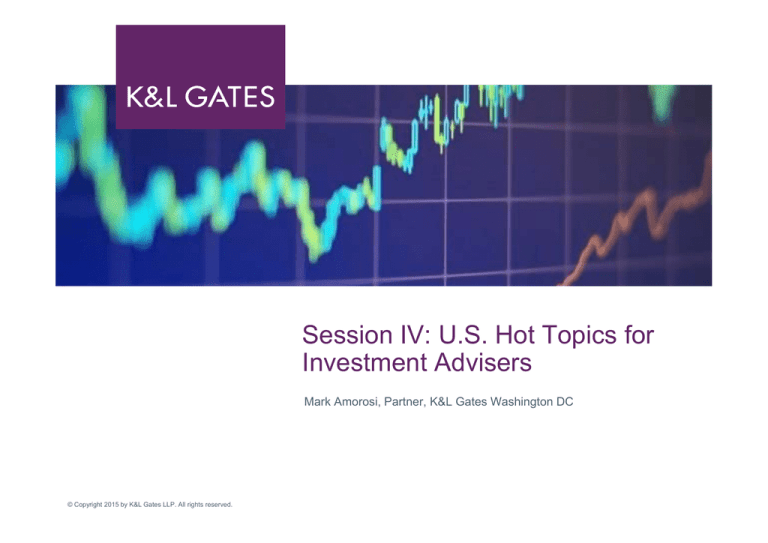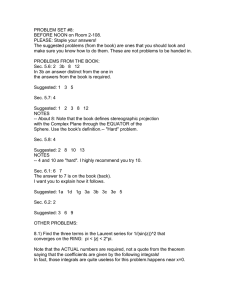
Session IV: U.S. Hot Topics for
Investment Advisers
Mark Amorosi, Partner, K&L Gates Washington DC
© Copyright 2015 by K&L Gates LLP. All rights reserved.
Topics
Systemic Regulatory Initiatives
Cybersecurity
SEC’s OCIE Sweep Exams and Priorities
Money Market Funds
Systemic Regulatory Initiatives
SEC Systemic Regulatory Initiatives
Adviser and Fund Data Reporting Modernisation
Proposal
Enhancing Controls on Risks
Transition Planning for Advisers
Adviser Data Reporting – Form ADV
Amendments to Form ADV
Proposal would require investment advisers to provide
additional information to the SEC and investors,
including:
Aggregate information related to assets held and use of
borrowings and derivatives in separately managed accounts
Additional information about an adviser’s advisory business
and including branch office operations and the use of social
media
Proposal also would permit by rule certain “umbrella
registration” filing arrangements that are currently
outlined in staff guidance
99
Data reporting – New Form N-PORT
Monthly Portfolio Reporting
New Form N-PORT, would require registered funds (other than
MMFs) to provide portfolio- and position-level holdings data to the
SEC monthly, including:
Data related to the pricing of portfolio securities.
Information regarding repurchase agreements, securities lending
activities, and counterparty exposures.
Terms of derivatives contracts.
Discrete portfolio-level and position-level risk measures to better
understand fund exposure to changes in market conditions.
Rescind Form N-Q
100
Data Reporting – New Form N-CEN
Annual Census Reporting
New Form N-CEN would require registered funds to
annually report certain census-type information to the
SEC, including streamlined and updated information
reported to the SEC to reflect current information
needs, such as requiring more information on
exchange-traded funds and securities lending.
Rescind Form N-SAR
101
Data Reporting – Financial Statements
Enhanced Financial Statement Disclosure
Proposed amendments include requirements to
provide, for example:
Specific information related to derivatives, including more
details regarding swaps, futures, and forwards.
Information in the notes to the financial statements relating to a
fund’s securities lending activities.
Prominent placement of derivatives disclosure in the financial
statements, rather than in the notes.
102
Electronic delivery of reports
Proposal would permit mutual funds and other registered
investment companies to provide shareholder reports by
making them accessible on their website, as well as the
funds’ quarterly portfolio holdings for the past year, rather
than printing and mailing shareholder reports
Funds would be required to send notices to investors
regarding the change to electronic delivery and online
availability of shareholder reports on a regular basis
Preserves paper delivery option for shareholders electing
that option
103
Risk management initiatives
SEC Chair White, “Enhancing Risk Monitoring and Regulatory
Safeguards for the Asset Management Industry” (December 11, 2014)
“[A] broader set of proactive initiatives is required to help ensure that [the SEC’s]
regulatory program is fully addressing the increasingly complex portfolio
composition and operations of today’s asset management industry”
SEC staff is developing recommendations for the SEC that would require
funds to implement additional risk management and compliance requirements:
Liquidity – (1) additional guidance on implementing current liquidity requirements for
open-end funds and (2) a rule proposal that would require open-end funds to
maintain liquidity management programs
Derivatives – new rules to address funds’ use of, and disclosure relating to,
derivatives
Stress Testing – new rule to require large asset managers and large funds
(pursuant to Section 165(i) of the Dodd-Frank Act) to conduct stress tests and to
report the results of such tests to the SEC and disclose the results to investors
104
Transition planning Initiative
SEC Chair White, “Enhancing Risk Monitoring and
Regulatory Safeguards for the Asset Management
Industry” (December 11, 2014)
“If we have learned nothing else from the financial crisis, it is that
we must test and plan for the worst…. [The SEC] must take steps
to ensure that firms have a plan for transitioning their clients’
assets when circumstances warrant.”
Staff developing proposal to require investment advisers
to create transition plans to prepare for a major disruption
in their business
May cover a wide variety of circumstances, including an
adviser’s dissolution and the departure of key personnel
105
Cybersecurity
CYBERSECURITY – TOP OF MIND
2011
• SEC Corp Fin Disclosure Guidance
• SEC adopts Regulation S-ID
2013
2014
• SEC Roundtable
• OCIE Risk Alert and Sweep Exams
• CFTC Best Practices
2015
• OCIE Risk Alert and Sweep Exam Summary
• FINRA Report on Cybersecurity Practices
• OCIE Exam Priority
• IM Guidance Update
107
SEC cybersecurity sweep exams
SEC’s Office of Compliance Inspections and Examinations examined 49 registered
investment advisers and 57 registered broker-dealers in 2014 as part of its
Cybersecurity Exam Initiative and issued a Risk Alert summarizing its observations in
January 2015. Primary observations included:
Most advisers (74%) reported that they have been the subject
of a cyber-related incident
The vast majority of examined advisers (83%) have adopted
written information security policies, and over half of them
(57%) audit compliance with these policies
A high percentage of examined advisers report conducting
firm-wide inventorying, cataloging, or mapping of their
technology resources
The vast majority of the examined advisers conduct periodic
risk assessments
Almost all of the examined advisers (91%) made use of
encryption in some form
Approximately half of the examined advisers (53%) are using
external standards and other resources to model their
information security architecture and processes
Approximately a third (32%) of the examined advisers require
risk assessments of vendors with access to their networks
Approximately a quarter of examined advisers (24%) include
cybersecurity requirements in contracts with vendors
108
Approximately a third of the examined advisers (30%) have
an individual assigned as the firm’s chief information security
officer
Written business continuity plans often address the effect of
cyberattacks or intrusions, but only about half (51%) of
adviser policies discuss mitigating cybersecurity incidents
Approximately a quarter of examined advisers (21%) maintain
insurance that covers losses and expenses from
cybersecurity incidents
SEC IM Guidance Update (April 2015)
Implications for compliance programs and regulatory risk
exposure:
Identify compliance obligations and how these obligations relate to
cybersecurity and detection and response to cyber attacks
Assess whether there are measures in place that are designed to
mitigate exposure to cybersecurity risk
Examine whether compliance program addresses cyber risks
relating to:
109
Identity theft and data protection (Regulations S-P and S-ID)
Business continuity
Fraud (codes of ethics – insider threats)
“Other disruptions in service that could affect, for instance, a fund’s
ability to process shareholder transactions” (Section 22(e) and Rule
22c-1)
SEC IM Guidance Update (April 2015)
SEC staff identified a number of measures that advisers
and funds “may wish to consider” in addressing
cybersecurity risk, including:
Periodic assessments
110
Information held
Threats and vulnerabilities
Existing controls
Potential effect of an incident
Cybersecurity governance structure
Implementation through written policies and procedures and
training
Routine testing to examine and enhance effectiveness of any
strategy
SEC’s OCIE Sweep Exams and Priorities
Sweep exams by the SEC
“Distribution in guise”
Begun in 2013, sweep focused on mutual fund distribution fees
SEC staff recently indicated that it completed the sweep
Several related enforcement actions are expected
SEC assessed the payment amounts, services provided, and the
“interaction of the service agreements”
Focus of the sweep exam
Underlying notion that payments ostensibly for sub-transfer agency,
recordkeeping, or other services were effectively for distribution
SEC looked for link between payments and distribution not previously
disclosed and potential Rule 12b-1 violations
Particular focus on direct or indirect connections to a preferred fund
arrangement, marketing, promotion, or access to investors
112
Sweep exams by the SEC
Fixed-income funds
Sweep is in response to expected volatility in the bond market due
to potentially rising interest rates
SEC is also focused on disclosure about the effect from rising
interest rates and board oversight of bond funds
Sweep is expected to cover 25 to 30 firms
OCIE priority for 2015
Focus of the sweep exam
Policies and procedures related to liquidity risks and illiquid assets
Results of stress tests of portfolio liquidity
Board oversight of liquidity management
113
Sweep exams by the SEC
Alternative funds
Focused on those funds with nontraditional asset classes and/or
strategies
Risks posed by valuation, liquidity, leverage, and disclosure
Initial sweep examined 15 to 20 complexes
OCIE priority in 2015
Focus of the sweep exam
114
Use of derivatives (portfolio holdings and trade blotters)
Risk management regarding alternative funds and holdings
Pre-trade/post-trade compliance results
Liquidity (assessment of fund’s liquidity; stress testing)
Valuation
Money Market Funds
Money market fund reform – Key Changes
Floating NAV
Institutional MMFs will be required to price their shares based on a “floating” NAV
Government and retail MMFs may continue to maintain a stable NAV of
$1.00/share
Liquidity Fees and Gates
All MMFs will be permitted to impose liquidity fees and temporarily suspend
redemptions (impose “redemption gates”) during periods of market stress
In certain cases, MMFs (except govt. MMFs) will be required to impose liquidity
fees
Diversification: MMFs must meet enhanced diversification requirements
Stress Testing: MMFs must satisfy enhanced stress test requirements, including
ability to maintain liquid assets of at least 10% and to “minimise principal volatility” in
response to certain events
Disclosure: MMFs must satisfy new disclosure requirements, including new Form
N-CR and website disclosure and amended registration statement and Form N-MFP
disclosure
116
Compliance Dates
Floating NAV
Liquidity Fees and Redemption
Gates
Diversification
Stress Testing
New Rule 30b1-8 under the 1940
Act
Form N-CR (other than Parts E-G)
Website Disclosure Related to
Form N-CR (other than Parts E-G)
Advertising
Form N-1A
Form N-MFP and amended Rule
30b1-7 under the 1940 Act
Website Disclosure Not Related
to Form N-CR
Form N-CR Parts E-G
Website Disclosure Related to
Form N-CR Parts E-G
October 14, 2016
October 14, 2016
April 14, 2016
April 14, 2016
July 14, 2015
July 14, 2015
July 14, 2015
April 14, 2016
April 14, 2016
April 14, 2016
April 14, 2016
October 14, 2016
October 14, 2016
117




